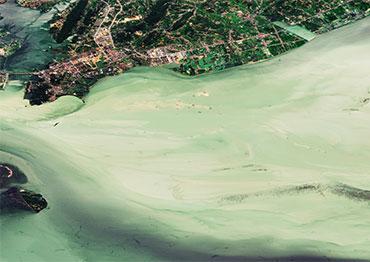As temperatures stayed above 40 C in a massive area along the river for several weeks, it has been the hottest summer in China’s recent history. The duration, intensity, extent and impact of the more than 70-day heat wave have been the biggest since 1961, Xiao said, adding that the average national temperature in August was 22.4 C, 1.2 C temperatures higher than the seasonal norm. According to statistics from the Ministry of Emergency Management of China, in August, high temperatures in the southwest, central and south of China lasted five to 10 days more than the same month in previous years.
The persistent heat waves, along with a lack of precipitation, brought unprecedented drought, with the Yangtze River Basin the worst-affected area. China’s longest and the world’s third-longest river, the Yangtze runs for over 6,300 kilometers through 11 provinces and municipalities, and it is the most vital waterway to China’s economy, providing water to more than 400 million people.
The long-lasting drought caused water flows on the Yangtze’s main channel to decline by 50 percent. Pictures of people sitting in dried up river beds in the middle of cities have gone viral. According to China’s Ministry of Emergency Management, precipitation on the Yangtze River Basin in July and August totaled just 160 millimeters, 49.6 percent of a normal year and the lowest since 1961.
In August, average national rainfall fell by 23.1 percent to 82.4 millimeters. This is the third-lowest since records began, Xiao said at the NMC briefing.
In Sichuan Province in the upper reaches of the river, where 80 percent of power comes from hydropower, the drought forced the provincial government to impose electricity rationing on industry, as water flow to Sichuan’s hydropower reservoirs dropped by half compared to the previous summer while electricity demand increased by a quarter.
Downstream in Jiangxi Province on August 6, the water level of Poyang Lake, China’s largest freshwater lake, declined below 12 meters, technically the dry season line, 69 days earlier than the average date between 2003 and 2021.
“In the past, the water level in Poyang Lake dropped under the dry season line only in October, rarely in September, and never in August,” Wu Guocai, director of the bureau of water resources in Chudu County in Jiangxi told NewsChina. By August 29, the surface area of Poyang shrank to 465 square kilometers, just one-sixth of its normal size in summer.
Elsewhere in Jiangxi, 1,734 reservoirs reached “dead pool status,” meaning that water can no longer flow downstream. Over 40,000 ponds completely dried up, according to provincial authorities.
In Chongqing along the upper reaches of the Yangtze, home to 31 million people, 66 rivers and 25 reservoirs had dried up by August 16. In Beibei District, the temperature reached 45 C on August 17, an all-time high ever recorded in China’s recent history. The searing heat set off wildfires in the hills and forests on Chongqing’s outskirts, where tens of thousands of firefighters and volunteers worked to put out blazes. There were 62 forest wildfires in August, mainly in Chongqing, Sichuan, Hunan and Jiangxi, much more than the last year. The drought in July and August affected more than 38 million people and nearly 41 square kilometers of crops, with direct damages of 328 million yuan (US$47m) according to the statistics that was published by Ministry of Emergency Management.
Lü Juan, director of the Research Center on Flood and Drought Disaster Reduction under the Ministry of Water Resources, told NewsChina that although summer is more associated with flooding in the Yangtze River Basin, summer drought is not new.

 Old Version
Old Version



